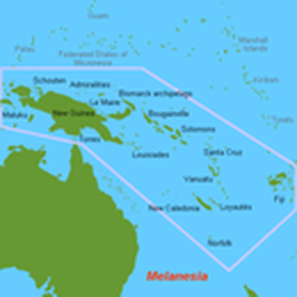Melanesia : ” islands of the
black-skinned people"
Melanesia (from Greek: μέλας black, νῆσος island) literal meaning is "islands of the black-skinned people".
Melanesia is a subregion of Oceania extending from the western side of the West Pacific to the Arafura Sea, north and northeast of Australia.
The term was first used by Jules Dumont d'Urville in 1832 to denote an ethnic and geographical grouping of islands distinct from Polynesia and Micronesia.Today, d'Urville's racial classification is regarded to be inaccurate because it ignores the broad cultural, linguistic, social and genetic diversity in the area. There is no one 'Melanesian culture' or way of life. However, there is a widely used geopolitical conception of the term 'Melanesia'. For example, the Melanesian Spearhead Group Preferential Trade Agreement is a regional trade treaty governing the states of Vanuatu, Solomon Islands, Papua New Guinea, and Fiji. Melanesia is also current as a geographic term, used as a reference to the area when national, ethnic, and linguistic distinctions are not relevant.
People
The original inhabitants of the islands now named Melanesia were likely the ancestors of the present day Papuan-speaking people. These people are thought to have occupied New Guinea tens of millennia ago and reached the islands 35,000 years ago (according to radiocarbon dating). They appear to have occupied these islands as far east as the main islands in the Solomon Islands (i.e., including San Cristobal) and perhaps even to the smaller islands farther to the east.It was particularly along the north coast of New Guinea and in the islands north and east of New Guinea that the Austronesian people came into contact with these pre-existing populations of Papuan-speaking peoples, probably around 4000 years ago. There was probably a long period of interaction that resulted in many complex changes in genetics, languages, and culture. It is likely that from this area a very small group of people (speaking an Austronesian language) departed to the east to become the forebears of the Polynesian people. This finding is, however, contradicted by a study published by Temple University finding that Polynesians and Micronesians have little genetic relation to Melanesians; instead they found significant diversity of between groups living within the Melanesian islands. (*) Genome scan shows Polynesians have little genetic relationship to Melanesians. #
Melanesia is a subregion of Oceania extending from the western side of the West Pacific to the Arafura Sea, north and northeast of Australia.
The term was first used by Jules Dumont d'Urville in 1832 to denote an ethnic and geographical grouping of islands distinct from Polynesia and Micronesia.Today, d'Urville's racial classification is regarded to be inaccurate because it ignores the broad cultural, linguistic, social and genetic diversity in the area. There is no one 'Melanesian culture' or way of life. However, there is a widely used geopolitical conception of the term 'Melanesia'. For example, the Melanesian Spearhead Group Preferential Trade Agreement is a regional trade treaty governing the states of Vanuatu, Solomon Islands, Papua New Guinea, and Fiji. Melanesia is also current as a geographic term, used as a reference to the area when national, ethnic, and linguistic distinctions are not relevant.
People
The original inhabitants of the islands now named Melanesia were likely the ancestors of the present day Papuan-speaking people. These people are thought to have occupied New Guinea tens of millennia ago and reached the islands 35,000 years ago (according to radiocarbon dating). They appear to have occupied these islands as far east as the main islands in the Solomon Islands (i.e., including San Cristobal) and perhaps even to the smaller islands farther to the east.It was particularly along the north coast of New Guinea and in the islands north and east of New Guinea that the Austronesian people came into contact with these pre-existing populations of Papuan-speaking peoples, probably around 4000 years ago. There was probably a long period of interaction that resulted in many complex changes in genetics, languages, and culture. It is likely that from this area a very small group of people (speaking an Austronesian language) departed to the east to become the forebears of the Polynesian people. This finding is, however, contradicted by a study published by Temple University finding that Polynesians and Micronesians have little genetic relation to Melanesians; instead they found significant diversity of between groups living within the Melanesian islands. (*) Genome scan shows Polynesians have little genetic relationship to Melanesians. #
